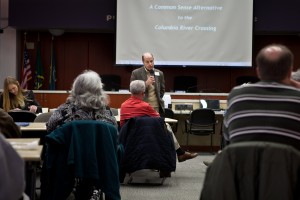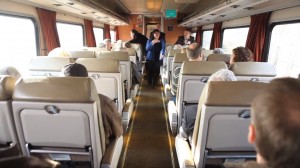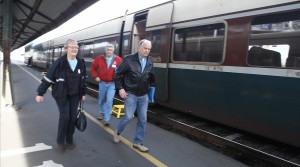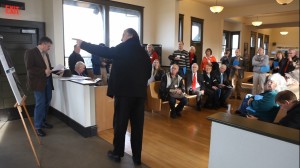Opponents of the Columbia River Crossing Light Rail project aren’t ready to give up the fight just yet – not by a long shot.
Members of the newly formed Smarter Bridge Committee hosted a tour Saturday to highlight alternatives they say are more affordable and sensible than the mammoth $3.1 billion to $3.6 billion Columbia River Crossing (CRC) project. They also say their options were never adequately evaluated during the CRC planning process.
“We’re trying to find allies in our fight to stop this project and replace it with alternatives we really can afford,” said Smarter Bridge Committee Chairman Ron Buel.
About 36 guests – including elected officials, representatives of labor and trucking, CRC staff, and residents of potentially impacted neighborhoods – gathered at the Clark County Public Service Building in Vancouver for a series of presentations promoting four different alternatives to the CRC.
The group also embarked on a short bus, train, and light rail tour covering the CRC project impact area as well as sites where alternative bridge and rail lines could be located.
The CRC project calls for the replacement of the existing Interstate Bridge with two 5-lane spans, reconstruction of six major highway interchanges, and the extension of light rail from Portland to Vancouver. The CRC hopes to fund the project through a combination of $1.2 billion in federal transit funds, $900 million from Washington and Oregon, and a projected $1 billion in tolls. Total construction will last eight years.
Smarter Bridge Committee members argue that increasing capacity at the bridge will just exacerbate traffic bottlenecks at Delta Park and the Rose Quarter further south in Portland. They advocate using supplemental, multi-modal bridges that would carry a combination of vehicles, truck freight, light rail, heavy rail, and even high-speed trains, thus lessening the dependence on I-5 alone.
Alternatives not fully vetted
Event planner and Smarter Bridge Committee member Sharon Nasset, who has long advocated for a west highway bypass running from West Vancouver to Swan Island in north Portland, feels these concepts were largely ignored by CRC planners during their $140 million environmental phase.
“A range of alternatives was not fully studied, and that is what would be best for our economic future, and so we are insisting that now that they have their study complete, that does not mean that it should be developed and other alternatives can be looked at,” she said.
Of the four distinct alternatives the Smarter Bridge Committee presented, each calls for construction of at least one supplemental bridge, seismic improvements on the twin Interstate Bridge spans, and modification on the BNSF rail bridge a mile west.
The alternatives include:
- The “Cascadia Multi-Modal Bridge” would run adjacent to the Vancouver Burlington Northern Santa Fe (BNSF) rail bridge and accommodate high-speed rail, rapid transit, freight trains, and motor vehicles.
- The “Common Sense Alternative” includes construction of a new lift span on the BNSF rail bridge, a new multi-modal Portland Harbor bridge, a new multi-modal passenger rail bridge, seismic upgrades to the Interstate Bridge, and a third multi-modal bridge connecting Hayden Island and Vancouver.
- The “Twin Bridges Solutions” involves inserting two new lanes between the north and south Interstate Bridge spans and raising the height of both by 18 feet to accommodate all river traffic. The second component includes building a twin arterial and light rail bridge parallel to the BNSF rail bridge.
- The “Third Bridge Now” plan calls for construction of a west freeway bypass that will cross the Columbia next to the BNSF rail bridge and continue on to connect to I-5, Highway 30 at Linnton, and Swan Island in North Portland.
Railroad bridge modifications needed
In order to address the issue of bridge lifts on the Interstate Bridge, the Smarter Bridge Committee presumes that the swing span on the BNSF rail bridge one mile west will be replaced by a more central lift span. (As if on cue, the bus tour got stuck in a traffic jam on the Interstate Bridge due to a bridge lift during the return to Vancouver.)
Currently, the BNSF rail bridge has a swing span located next to shore. This forces boats and barges that want to use the elevated “hump” in the center of the Interstate Bridge spans to complete an “S” curve maneuver before reaching the BNSF bridge. Otherwise, they will use the Interstate Bridge lift and hug the shore between the two bridges.
Adding a central lift span to the BNSF will allow the vast majority of river traffic to stay in the center of the river.
There were no representatives of the BNSF or Coast Guard present at Saturday’s gathering. A BNSF spokesperson later confirmed that the company has had conversations about altering the BNSF bridge with state officials, but would offer no further details.
All-in-one requirement short-sighted
Smarter Bridge Committee member Floyd Smith said in a prepared statement that the reason some of these alternatives never made it deep into the CRC planning process is that the CRC insisted they be an “all–in-one” plan that addressed vehicle capacity, transit, fright mobility, safety, bicycle and pedestrian mobility, and seismic risks.
CRC planners eliminated commuter rail as an option because it didn’t integrate with bus or other rail service. Smith, the government affairs director for the Association of Oregon Rail and Transit Advocates, believes that was akin to throwing the baby out with the bath water.
“Nobody’s denying, from the standpoint of the Smarter Bridge Committee, that we need to induce business travel here and passenger travel – it’s just how are you best, most efficiently going to do it,” he said. “From my perspective, one way to do it is to get people on trains and rail because that’s where the efficiencies are.”
CRC Director Nancy Boyd attended the event and said that while she enjoyed the group’s enthusiasm, the CRC has completed its public process and is moving on.
“I do think it’s a little misguided in that I love to see all energy but we’ve gone through that as part of our public process,” Boyd said. “Now it’s time to take what has gone through this public process and refine it into a project that will be built in the next few years.”
Another guest on the tour, Vancouver resident Howard Leighty, also wasn’t swayed by the Smarter Bridge Committee’s arguments. He believes the CRC is the right solution.
“Who are these experts who think they have new ideas?” he said. “Leave it to the engineers. Engineers aren’t trying to waste money.”
Other guests came away supportive of the tour and hope that the word will spread to the public and elected officials that the CRC is not a done deal.
Jim Johnson, who co-owns Woodland Truck Line in Woodland, says truckers would pay far more in tolls than regular drivers. He agrees that something must be done about the congestion on I-5 but worries that the will of the people will be trumped by government planners.
“Hopefully we’ll get where we the people get to speak and it’s not decided by someone who thinks they know better,” he said.
See our continuing coverage of the Columbia River Crossing Light Rail project.
Do you have information to share on the CRC? To respond anonymously call 260-816-1426. To allow your comments to be used on COUV.COM call 260-816-1429.













